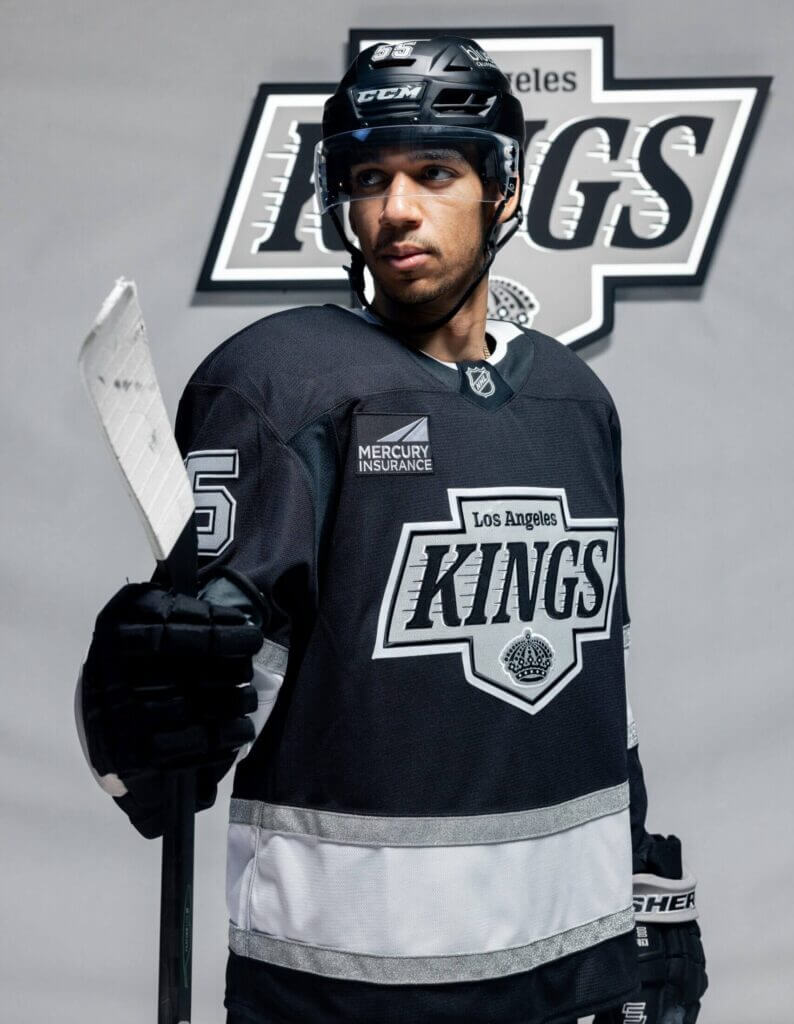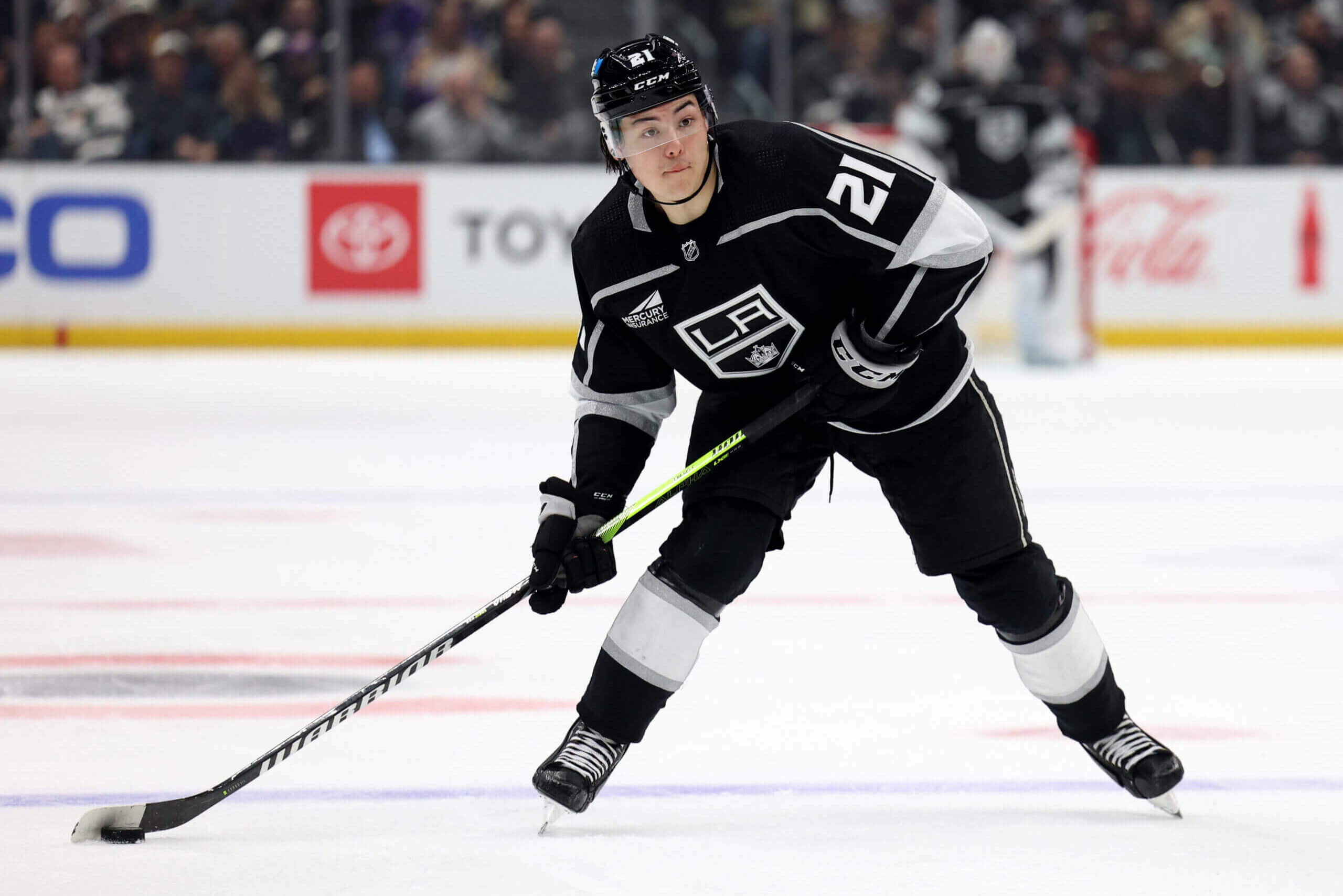The Los Angeles Kings unveiled their new home and road jerseys on Wednesday, but if anyone was paying attention during the Stanley Cup Playoffs – and there were surely many among their fans – they saw the direction that the franchise was planning to take with its latest name change.
In their three road games against Edmonton, the Kings wore their alternate white jerseys featuring the “chevron” style logo that was originally introduced in 1988, with the arrival of Wayne Gretzky, and which was introduced periodically over the years. (Although “chevron” is the official reference to the Kings brand, the logo’s angular features also resemble those of the Chevrolet automobile brand.)
This look is back by popular demand, replacing the “shield” style look that the Kings introduced as an alternative in 2008-09 and then adopted as their primary look at the start of the 2011-12 season. The Kings won the Stanley Cup twice in these uniforms and were more successful than in Gretzky’s era. But you should never underestimate the appeal of nostalgia.
Woven into the fabric of Los Angeles.
https://t.co/0vaApVA21I#GoKingsGo pic.twitter.com/X5nuorj4Oz
– Los Angeles Kings (@LAKings) June 26, 2024
“We’ve seen fans wear this jersey for years, whether they bought it recently through Mitchell & Ness or one of the other heritage brands, or they picked it up from the 80s and 90s when they bought it for the first time and they still wear it,” said Kelly Cheeseman, chief operating officer of the Kings. “When you go to a Kings game, for better or worse, you see a plethora of jerseys from all eras. And that’s where we really had the first instinct to start looking at the process when they were brought back, and we decided to take them to the ice.
“We began bringing in companies that have gone undefeated as brand partners to sell new products inspired by this inspiration. You started to see the popularity and also new generations and new fans from different parts of the city who were like, “It’s cool if you want to be a part of it.” »

Phillip Danault wears the new road jersey. (Courtesy Los Angeles Kings)
Any surprise to Cheeseman about how a return to the 1990s look would be received has long since evaporated. In 2019-20, the Kings unveiled – to heavy criticism from fans – their heritage jersey, which incorporated the chevron logo but with a “Forum Blue” and gold scheme.
The Kings had further logo and uniform changes in the late 1990s and 2000s, with a reinvented modernized crown and the reintroduction of purple for a time. Purple was officially discontinued for the 2011-12 season.
The look of the shield – or “home plate” – which was primarily black and white, with silver reduced to accented stripes, was not universally well received. But hordes of Kings fans still bought the jerseys, and seeing them worn at games was ubiquitous. The new hockey jerseys are also generating interest. But success can also influence an item’s popularity, and it didn’t hurt sales when the Kings won the Stanley Cup in 2012, their first full-time season, and again in 2014.
So why turn away from it, if it means success? The reception given to the historic jersey certainly played a major role. But it wasn’t just fans who motivated the rebranding process, which began before the COVID-19 lockdown in March 2020.
“Our players loved playing in this jersey,” Cheeseman said of the heritage jersey. “Feel good, play well. Getting their feedback is really important. We asked them: “Are you ready to do this? They were like, “Yeah, let’s do it.” » …Their level of excitement about playing in that Gretzky-era jersey as a group was really, really high. It was exciting to see.
The Kings wore their heritage jersey 15 times last season. Many stakeholders from the past and present – including the current leadership group and other long-time veterans – were consulted several months ago for feedback on a change. This helped shape the decision to wear the white alternates for Games 1, 2 and 5 against Edmonton, and whet fans’ appetites.
“It was even the conspiracy theorists who thought we were going to go out in the third (home) game and have a new black with the brand,” Cheeseman said with a laugh. “I think it’s led us to where we’re going, in the right direction.”
Are the new jerseys directly inspired by what Gretzky wore when he set the NHL’s scoring and scoring records, or the Kings’ magical run to their first Cup final in 1993? Above all. There are slight differences between then and now, which Cheeseman says are “minimal.”

Quinton Byfield wears the new home jersey. (Courtesy Los Angeles Kings)
“To the average eye, they’ll probably ask, ‘What’s the difference?’” he continued. “For the casual fan, for the fan that maybe comes in once or twice a year or once every three years, then maybe it’s, ‘Oh, the Kings are wearing the ’90s logo now.’ But for the superfans and the hardcores, they’ll notice all the differences. Shapes and nuances. Stripes and crowns and all that, and that’s where it gets fun.
The most notable difference is in the official logo. It draws inspiration from the past, but there are modifications. The “KINGS” wordmark and the left and right edges are not as angled as the previous version. Fewer “speed lines” extending from the letters to represent movement are used.
The black and white outline is thicker and the black “Los Angeles”, on a lighter silver base, is in a different, bolder font. The crown is the most notable change, as it more closely reflects the original that debuted with the 1967-68 expansion season and was used until Gretzky’s arrival. Additionally, black numbers will be used on white jerseys instead of silver. (The Kings moved from silver numbers to black numbers in 1992-93). The sleeve numbers that appeared on the armbands in the 90s are located higher up in this version.
The Kings teamed up with Delaware-based House Industries for this brand. A first month of meetings stretched over two years. There were countless models to worry about. Fanatics, which becomes the official jersey supplier of the NHL, allowed the Kings and Anaheim Ducks to proceed with their rebranding since the teams were already well into the process.
“I can’t dare guess how much time and effort (House) put into this,” Cheeseman said. “Many different iterations. Fonts. Essentially, many different looks that weren’t even close to the ones we landed on. This is what you are experiencing. Interviews with former students, former broadcasters. A lot of people we gave them access to and they went into our archives. I really dug into things to get to the final product before presenting it to our executives and then ultimately to our owners to stamp it and say, “All right, let’s do this.” »

That Kings home jersey look is now a thing of the past. (Harry Comment/Getty Images)
There will be no alternate jersey for 2024-25, but Cheeseman said he is expected to wear one in 2025-26. Matte black helmets will be used with their home jerseys instead of those with a glossier finish. The shiny silver helmets, or “chrome domes,” that the Kings occasionally deployed will be gone for now.
This revelation also ends any hopes of the Kings returning to Forum blue and gold as their primary color scheme. There is still strong sentiment in favor of this project, and Cheeseman stressed that the Kings remain proud of their original look. He pointed out occasions where retro jerseys were used, for their 30th anniversary season or during “Legends Nights.”
There have been discussions about a return to this system. But black, silver and white have been part of the Kings’ identity for even longer. This differentiates them from the NBA’s Los Angeles Lakers, and they are the only Southern California team to use these colors, with the NFL’s Raiders long gone. Cheeseman understands and takes seriously fans’ emotional attachment to their favorite teams’ jerseys. The emotion can run especially deep when it comes to a hockey sweater.
“It’s fandom,” Cheeseman said. “Sports. It’s not rational. Being that much of a fan of any team or whatever, you don’t have to have a rational mindset to be that entrenched in something. But that’s what makes it great. For the fan who loves our jerseys so much and wants to look at them and our logos and wants to criticize them or celebrate them, that’s what we live for. this work every day. And all this was taken into account during our research.
“Are we going to make everyone perfectly happy with this?” Absolutely not. I’m hyper focused on the fact that there will be a group that wants it to be purple and gold. We are a black, silver and white team, but we have shown that we have flexibility in special cases. That’s what I think this brand is really going to celebrate and give us flexibility over time.
(Top photo courtesy of the Los Angeles Kings)